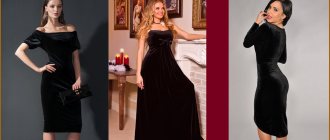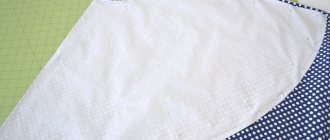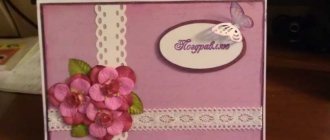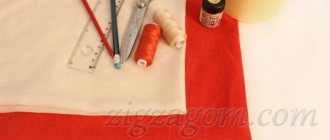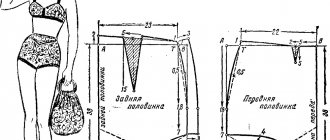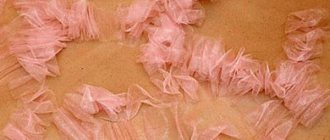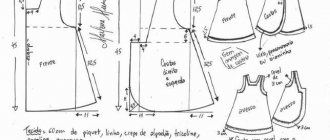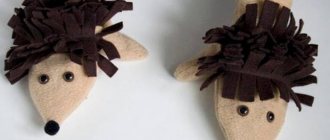Chiffon dress: photo
Creating a chiffon dress is very easy and simple, and you don’t need to have a lot of experience in sewing. So, first you need to take standard measurements for the dress - chest circumference, hips and waist, shoulder length, length of the future dress.
When choosing the color of a dress, you should consider where you plan to wear it - for example, a long dress made of peach-colored chiffon looks incredibly gentle and beautiful, which is perfect for a walk on a summer evening or going out.
LiveInternetLiveInternet
Electronic pattern for a dress with a difference in skirt length Sizes: 42-52
File format: PDF
Sewing difficulty level: easy
Another women's pattern for a trendy summer dress, which can be recommended for sewing by beginning couturiers.
The model is suitable for slender girls and young ladies.
The set of dress patterns includes patterns for the front, back and overskirt, sun flares with a wrap and length difference (Fig. 1). The pattern for the petticoat is a rectangle and is therefore not included in the pattern set.
For sewing, you can use any thin dress fabric (chiffon, cambric, thin silk), with the exception of highly stretchable stretch.
Fabric consumption for a dress is from 2 m to 2.5 m, depending on the size and length of the underskirt. Therefore, before purchasing fabric, you should make patterns using patterns, decide on the length of the underskirt and make a preliminary layout.
How to print a pattern
How to cut and sew a dress with a difference in skirt length with your own hands
Cutting such a dress according to the finished pattern is very simple (Fig. 2), but it is possible that you will have to cut it from “complex” fabric such as chiffon.
Fold the fabric in half, matching the edges, and place them parallel to the edge of the cutting table.
A little sewing lesson. If the fabric is slippery or very thin, first cover the table with a thick, heavy, non-slip blanket. Faux fur bedspreads will not work. If there are wrinkles in the blanket, iron them out. If there is no suitable table covering, you can cut it on a rug, directly on the floor. The main thing is that the coating does not slip.
Along the edges and in the middle, the fabric can be pinned with tailor's pins and patterns can be pinned onto it. For convenience, you can also pin together the patterns-fabric-table covering.
When cutting, you should also take into account the fact that it can be quite difficult to apply tracing lines to chiffon and cambric. You can use a pale marker, but I would not advise you to do this.
I recommend that after pricking the patterns onto the fabric, cut them out with the necessary allowances.
The skirt part does not require allowances, but its width is designed for fabric with a width of 1.4 m. If you buy fabric with a width of 1.5 m, you can add a uniform allowance along the bottom of the skirt.
The underskirt is a straight “tatyanka”, that is, a rectangle. It can be cut from the same fabric or from a companion fabric. The length of the skirt will be from 40 to 50 cm. The width is equal to the volume of the hips plus an increase, because it is desirable that the underskirt can be worn without a fastener. To save yourself the trouble of coming up with an increase, cut the petticoat after trying on the bodice according to its finished width.
By the way, the underskirt can be a separate item.
The allowances for cutting the details of the bodice are as follows: side, shoulder - 1 cm, sprout, neck, sprout, armholes - without allowance, along the waist line - 3 cm.
How to sew a chiffon dress
The sewing sequence is no different from the sequence of other models:
- Assembling the bodice.
- We process the bottom of the upper skirt (opsed or rolled seam - see “Machine seams”).
- Assembling the petticoat (vertical seams and bottom).
- We combine all three blanks into one whole.
Now let's take a closer look at the processing of the bodice . Despite its apparent simplicity, sewing a dress from chiffon and thin silk is not an easy task.
We start by processing the dart on the shelf. In general, you can ignore it or put it in a fold that is equal to the dart opening, or you can stitch it to 2/3 of the length. But first, no matter what processing method you choose, I recommend that you sweep the dart COMPLETELY, sweep the side and shoulder seams and try on the bodice.
When trying on, trim the neckline and armholes if necessary.
Another difficulty is sewing the shoulder and side seams. To “stabilize” the fabric, when overcasting, place a strip of interlining about 2 cm wide under the seam with glue to the fabric and overcast. Tear off the excess interlining; it is thin and breaks easily; cutting will take longer. After sewing, press the seams.
Edge the neckline and armholes. Read about how to edge a cut with bias tape without sewing equipment at home and how to make bias tape here.
The most suitable width for chiffon bias binding, if you use the method outlined in the article linked above, is 4 – 5 cm. Chiffon is a very unstable material! Therefore, a smaller width will make work more difficult.
To ensure that the ends of the edging are “clean”, we have to resort to one more tailor’s trick:
we process one shoulder seam, edge the neckline, process the second shoulder seam, then edge both armholes and edge the side seams.
We're done with the bodice.
The flared sun overskirt with a difference in length easily connects to the bodice. You should start basting by aligning the middle lines of the back and skirt.
After basting, it is advisable to try on the product and, having basted the same seam, sew the finished petticoat, slightly stretching the stitching and overcast.
Finally, along the seam allowance at the waist, but very close to the seam, sew a stitch with rubber thread wound around a bobbin.
Ready!
Pattern and description of a chiffon dress
As soon as the color and style of the dress is chosen, you need to start cutting the material; for this, a simple pattern is created. The future dress will consist of 2 parts - the 1st dress bodice, and the 2nd maxi length skirt. Taking into account the previously taken measurements, you need to make a paper pattern of the bodice, after which it is carefully transferred to the fabric.
You need to cut out 2 such parts from paper - one will be for the front, and the second will be for the back. You need to create a symmetrical pattern, and in order to get a single piece as a result, the fabric is folded in 2 layers and the pattern is placed on top of it. Then you need to cut it out and unfold it. When creating a pattern, it is worth considering that there should be a few centimeters of fabric left on the sides for seams.
It will be even easier to create a chiffon skirt for a dress. First, the required rectangular piece of fabric is prepared - it is important to ensure that its width is equal to the resulting waist volume multiplied by 3. It is this coefficient that will show the average fluffiness of the future skirt.
It is important not to forget about the lining, because chiffon is not only very light, but also translucent fabric. In almost all cases, the lining is slightly shorter than the main chiffon part, making the product look elegant and sophisticated. In this case, you can use the same chiffon or silk to match the main fabric as a lining.
The edges of the material must be machined, as they may fray. A vertical stitch is made along the wrong side of the product, which will connect the rectangle (skirt) along the edge.
To make the skirt emphasize your figure, you should use the simplest elastic band. The main thing is to measure the length of the elastic band correctly - the elastic band stretches a little at the waist and another 3 cm is added to the resulting length for an allowance.
The elastic is threaded into the belt, the width of which should be slightly larger than the elastic itself (plus 5 mm, but no more). Since chiffon is very see-through, in the upper part of the skirt the fabric must be folded in several layers and then stitched. In this case, a small section should be left unstitched, since the elastic will be pulled into the belt through it.
Next, the 2 ends of the elastic are sewn together, and it is carefully secured using a hand-made, invisible seam. Now the skirt of the future dress is completely ready.
The result is an interesting dress model consisting of a bodice and a skirt, which can be worn separately or together.
How to sew a simple evening dress with your own hands?
Do you urgently need to get an evening dress, but in your closet there are light scarves or stoles that you wouldn’t mind using for a good cause? Then here you go:
- Turn one of the scarves into a skirt by sewing it around the edges
- Sew elastic at the waist . It is highly desirable that the elastic band is the same color as the outfit, otherwise you will have to dodge with the disguise
- Take the second scarf, which will serve as a bodice , and with the shorter side, baste it to the elastic
- Pull the future bodice obliquely and wrap it behind the neck . Wrap around the neck and pull diagonally to the opposite side from the one from which you basted
- Baste the fabric on the opposite side as well . Alternatively, you can not throw the scarf diagonally, but wrap some ends around your neck, and put the others behind your back and sew them
- Take care of that part of the fabric that is adjacent to the back of the head - sew it beautifully
- Sew also the fabric in the neckline area
IMPORTANT: It is recommended to attach the bodice to the skirt with an elastic band - this way it will fit most neatly.
This simple evening dress can be made without a pattern from scarves
How to sew a dress from chiffon?
- To cut chiffon, it is recommended to use a circular knife and do it only on the backing. If it is not possible to use them, then you can place any backing under the chiffon, the main thing is that it does not slip, and to cut the fabric you can use simple tailor’s scissors.
- A paper pattern should be pinned with pins with a sharp end, since even a slight notch can completely ruin a piece of fabric. To attach pattern pieces, you can use a special adhesive spray or thin adhesive strips.
- If you use spray glue, then you need to place part of the pattern on the fabric strictly along the transverse (lobar) thread, and place a small weight in the middle. Now the edges of the pattern are treated with spray glue and left for a while for the glue to “set”, then the pattern is pressed tightly to the fabric.
- All markings and contours of the pattern pieces should not be transferred to chiffon using carbon paper or a toothed wheel, since the lines on the front part of the chiffon will begin to show through and unsightly marks from the wheel may remain.
- Placement of folds, seams and dart lines can be done using running stitches using fine thread and a fine needle.
- Chiffon must be ironed dry, as if moisture gets on the material, it can become very wrinkled. In order not to damage the fabric, the surface of the iron must not only be clean, but also perfectly flat, and the ironing process itself takes place through tissue paper.
- All details of the dress must be sewn with an exclusively thin needle; thin threads intended for machine embroidery are used, and the stitch length is no more than 2 mm.
- When sewing, tissue paper must be placed under the fabric, since the sewing machine conveyor can severely damage the material. The seam allowance is carefully sewn - it is best to use an overlocker.
How to sew a simple long dress with your own hands?
- Prepare a fabric twice as long as your height and a beautiful ribbon for your belt.
- Lay the fabric on the floor and mark the middle of it with a line using a chalk.
- Now cut a hole in the middle of this line for the head . Put the fabric on yourself
- Think about how long you want your neckline to be - it can go traditionally to the chest, or it can go to the waist. In the latter case, this cutout will be intercepted across with several tapes. In any case, use chalk to mark the desired length, and then lay the fabric again on the floor, make a slit to the mark
- Now put the workpiece back on , pin the fabric on the shoulders using decorative pins
- Make ribbons by tying them under the fabric. Either sew directly or pin together first for fitting - it's up to you
IMPORTANT: You don’t have to fuss too much with the stitches, because these tapes will have a fastening function. But you will have to attach more ribbons on top for decoration.
- Experiment with the back , finding the most interesting drapery options for yourself
- You can sew the future dress on the sides, or you can add elegant buttons
A simple floor-length dress without a pattern can be made revealing thanks to the neckline and cutouts on the sides
Chiffon dress models: examples
Every season, fashionistas are pleased with a wide variety of stylish and interesting models of dresses made of airy chiffon fabric. A large selection of styles will help you choose the perfect dress even for women with a non-standard figure, which can sometimes be very difficult to do.
To highlight the beauty of your waist, you should opt for models with full skirts and fitted tops. An excellent choice would be dresses in the empire style, which visually elongate the silhouette and add slimness to any figure. To attract attention to beautiful arms and back, a model with an open back is simply ideal. And to add sexuality and playfulness to the image, you need to choose styles of chiffon dresses with flirty slits.
Short dresses made of airy, flowing material are perfect for young fashionistas, and they are presented in a wide color palette. You can easily create a memorable image by choosing a bright dress, complemented by an original pattern. Or appear as a gentle romantic nature, giving preference to soft pastel shades.
Light chiffon dresses, sundresses or tunic dresses are ideal for summer. In addition, such models can be worn not only on vacation, but also to work in the office, without violating the dress code.
Designers also presented extraordinary chiffon dresses in their autumn-winter collections, which simply amaze with their original shapes and stylish patterns. And to create a complete and complete image, you need to choose the right accessories.
One of the advantages of chiffon dresses is that they not only drape well, but are also beautifully colored. Thanks to this you can choose a hippie style dress.
Models of mini and super-maxi dresses that give the impression of a flying gait do not lose their relevance. Models with deep necklines and high slits look stylish and seductive, while the dress itself can have a simple cut, which makes it even more interesting.
Romantic types will be able to choose dresses made of airy chiffon, complemented by delicate patterns. The designers also presented models in a classic style that are perfect for adult women and will not only emphasize the beauty of the figure, but also reliably hide minor imperfections.
Features of the material
The thinness of the material is achieved by using tightly twisted threads. It is made from natural or artificial fibers. Chiffon models suit the boho style. This light and airy fabric is used to create not only clothing, but also home textiles and accessories.
Red chiffon dress
This material is made using plain weave in most cases. Various types of threads can be used for it, which gives the fabric certain properties.
- Silk is obtained using the silkworm. Its threads have a triangular cross-section. Fabric made with their help can shimmer beautifully.
- When the material is made from cotton, it is thin, durable and absorbs moisture well. Clothes made from it are well suited for summer.
- This fabric can be made using viscose. This thread is artificial. It is produced using cellulose. The fabric made using it is durable and pleasant to the touch.
- When polyester is used for manufacturing, it gives strength to the material. This fabric does not wrinkle.
- Sometimes polyamide is used. It is known for its high strength.
Chiffon
When making fabric, various weave options can be used. Depending on the option used, the following varieties can be distinguished:
- To create crepe chiffon, the threads are twisted. Moreover, those that are nearby curl in opposite directions - one to the left, and the other to the right. This fabric is rough. Its peculiarity is that it practically does not wrinkle and drapes well.
- Chiffon jacquard has large woven patterns that resemble embossing.
- Another variety is satin chiffon. The warp threads are wrapped around the weft many times. These weaving features make the fabric smooth.
- A chameleon plays with different colors depending on the angle and strength of the light falling on it. The master will be able to make a real masterpiece from such fabric.
- Pearl chiffon resembles the previous variety with the difference that it shimmers with a mother-of-pearl color.
- Although usually the raw edges of such material can easily fray, nylon chiffon does not have this drawback. In addition, it has higher strength compared to other varieties.
- In double-sided chiffon, the coloring of the outer and inner sides is different. It is often made contrasting.
You might be interested in this Methods of sewing T-shirts for a size smaller
A wide variety of types of material allows you to choose the most suitable fabric for sewing for girls or women.
Green chiffon


